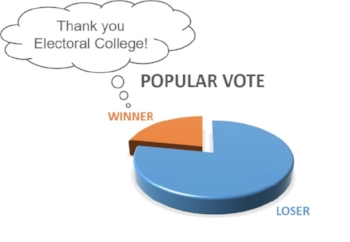In the US, the electoral college drives the presidential election. A candidate will win an election if they obtain more than half of the electoral votes (EV), regardless of the popular vote. For the fifth time in the history of this country, the candidate who won the presidential election, did not win the popular vote. These presidents are John Quincy Adams (1824), Rutherford Hayes (1876), Benjamin Harrison (1888), George W. Bush (2000), and most recently Donald Trump (2016).
In this last election, Hillary Clinton was estimated to have received 48.2% of the popular vote, compared to 46.5% received by Trump, which accounts for a difference of over 2 million votes.
So, what is the minimum number of votes that a candidate can have, and still win the presidential election?
For this investigation, we know that:
- There are 51 voting areas (50 states plus the District of Columbia) that together contain 538 EV.
- A candidate must accumulate at least 270 EV to win the election [1].
We will assume that:
- For each voting area, the winner takes all the EV. We are aware that this does not apply to Maine (4 EV) and Nebraska (5 EV); but, the difference in the results should not deviate significantly.
- he winning candidate will accumulate exactly half of the votes plus one vote on the states that they win [2].
- he winning candidate will receive 0 votes on the states they do not win, to minimize their popular vote.
- e will use the data from the most recent presidential election [3]. We will only consider the number of people who voted (not the number of people who are eligible to vote). Note that about 58% of the voter eligible population ended up voting.
- We will assume that there are only two candidates [4].
In the table below we present the data that shows for each state the number of EV, the total number of ballots counted, and the total number of votes needed to win all their EV.
The blue bar chart presented below displays the number of EV per state, and the orange line shows the accumulation of the EV. The top 11 states (California, Texas, Florida, New York, Illinois, Pennsylvania, Ohio, Georgia, Michigan, North Carolina and New Jersey) add up to 270 EV. The red bar chart displays the number of votes needed to win all the EV in that state, and the green line is the accumulation of votes. For the top 11 states, the candidate will accumulate at least 37,015,266 votes from a total of 135,649,464 ballots casted. Therefore, the election could be won with 27.28% of the popular vote. Similarly, if we group the remaining 39 states plus New Jersey and DC, we would accumulate 282 EV with 32,614,514 votes. The result is an election won with 24.04% of the popular votes.
To further the analysis, we need to determine if there are other ways of grouping the states that will provide 270 EV or more, while maintaining an even lower number of popular votes. A solution would be to calculate all possible combinations of states. This task is not practical given the large amount of options. For example, if we would like to determine how many ways we can combine 25 of the 51 areas, we would obtain over 247 trillion results.
An alternative to testing all combinations, is to test a subset of all combinations, and expect that we will obtain a better outcome; even though it may not necessarily be the best solution. In this case, we tested 100 million of these outcomes and analyzed the one with the lowest number of votes.
Thus, we obtained that with 31 states and DC we can get 29,837,415 votes which accounts for 21.99% of the popular vote. Below we display the states needed to win this election.
Due to the current electoral college system, candidates can target their campaign without focusing on the popular vote. Nevertheless, if the system were to be replaced by the popular vote, the campaign strategies will change dramatically.
In summary, a candidate can become president of the US with about 22% of the popular vote, as long as the votes are distributed strategically across the states and DC.
[1] We are ignoring the fact that the electoral college can select a different president than the one voted by their constituents.
[2] Winning a state by only 1 vote will trigger recounts that will take a long time to sort out. However, it is technically correct to win this way.
[3] Results are not final. Data file was obtained on 11/29/2016.
[4] Calculations will vary when 3 or more candidates are included.

